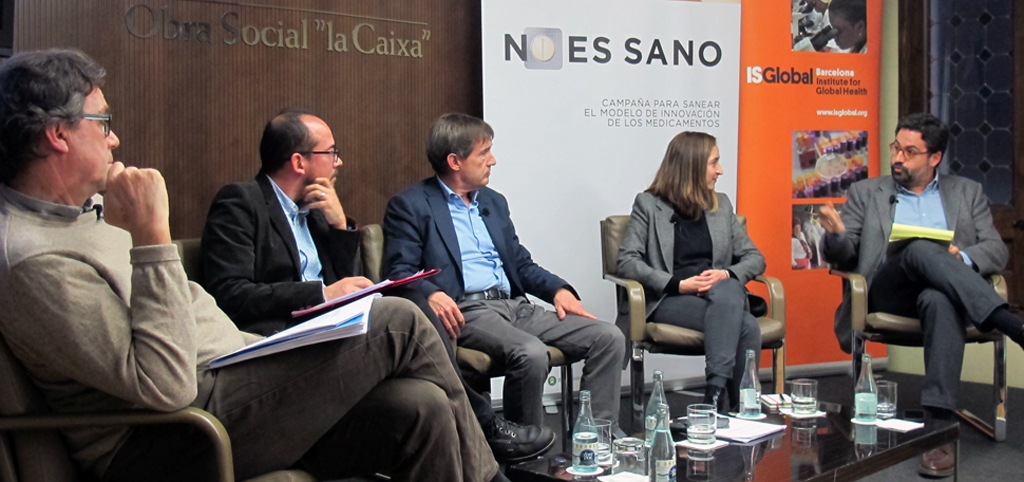“No Es Sano” Demands a Pharmaceutical Innovation Model that Guarantees Universal Access to Medicines
The campaign, the work of an alliance of several organisations, was presented in Barcelona with the support of ISGlobal
16.03.2016
Pharmaceutical R&D operates according to a complex, opaque model that creates huge inequalities in access to medicines globally,” commented Gonzalo Fanjul, Policy Director at the Barcelona Institute for Global Health (ISGlobal), in his opening remarks at a recent panel discussion in Barcelona entitled “The Price of Medicines Is Not Healthy: Alternatives to a Broken R&D Model”.
The event was organised to launch the “No Es Sano” (“It’s Not Healthy”) campaign in Barcelona. The initiative—involving an alliance of more than a dozen health organisations, including ISGlobal—is calling for an overhaul of the current biomedical research system in order to ensure universal access to medicines.
One of every three people in the world today does not have access to the medicines they need to guarantee them a decent life. Mr Fanjul asked each panellist to identify the most important change they believe needs to be made in the pharmaceutical R&D system in order to reduce this inequity.
Vanessa López, Executive Director of the Right to Health Foundation, argued that the essential problem is “the industry’s patent system, which creates monopolies”. The Agreement on Trade-Related Aspects of Intellectual Property Rights (TRIPS) requires member states to grant exclusive rights for 20 years for patents and for at least 8 years for data. “The only goal is to make a profit,” commented Ms. López. “It’s important to recognise innovation, but at the same time, medicines should be a public good.” She also noted that most “new” drugs are nothing of the sort: “Only 7% of drugs developed between 2000 and 2007 had added therapeutic value.”
Joan Bigorra, Deputy Director of Strategy and Innovation at ISGlobal, noted that the problem is not only the pharmaceutical industry and argued that the state should play a bigger role: “The industry operates in accordance with market incentives, so it is up to the buyer to reformulate the system.” Dr Bigorra argued that governments are responsible for the health of their people and should therefore “exercise their buying power”. He also dispelled the myth that only pharmaceutical companies invest in R&D: “More than 60% of innovations come from the public sector, but these discoveries—and the profits they generate—end up in the hands of pharmaceutical industry.”
Rodrigo Barahona, Director of the Planning, Monitoring and Learning Unit at Oxfam Intermón, described the pharmaceutical industry’s lack of transparency as a major problem and called for greater openness. Mr Barahona cited the “10-90 gap”—the fact that only 10% of all pharmaceutical R&D resources are spent on the diseases that affect 90% of the world’s population. He added: “Each year, 100 million people fall into poverty as a result of having to pay for treatments and medicines they need.”
Finally, Olaf Valverde, Medical Manager at the Drugs for Neglected Diseases initiative (DNDi), noted that the current model is unable to detect the real needs of the population. “The most important health problems are also the most neglected”, he commented. In some cases, Dr Valverde noted, drug prices have risen exorbitantly. He cited the example of the treatment for hepatitis C, which in the United States has reached the “outrageous” price of $84 000 per patient.
New series of reports on innovation
During the session, ISGlobal introduced its new series of reports on innovation and access to medicines. The first of these, Biomedical Innovation and Access to Essential Medicines: Alternatives to a Broken Model, analyses the current research system and sets the stage for a debate involving all the stakeholders with the aim of finding a balance between pharmaceutical innovation, the public interest and access to essential treatments.
More information
ISGlobal’s work on pharmaceutical innovation and access to medicines
Report: Biomedical Innovation and Access to Essential Medicines: Alternatives to a Broken Model



